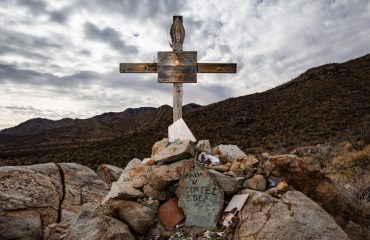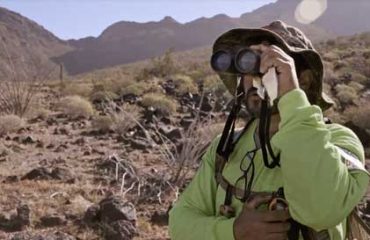“Sweet Water” – Humane Borders Station named for Famed Author Luis Alberta Urrea
by Paul Ingram
Along the sandy desert road known as the El Camino del Diablo, or the Devil’s Highway, a blue flag wafts lazily in the cool morning air. At the base on the flag is a blue 55-gallon barrel filled with agua dulce—sweet water—both a good name for water in the midst of open desert, and the name of Humane Borders’ water station, one of dozens maintained throughout southern Arizona.
On Valentine’s Day, the desert air is cool, but the sun is already starting to stoke its heat, and at Agua Dulce, volunteers from the humanitarian aid organization greet award-winning author Luis Alberto Urrea to the station, and present him with a gift: the station will now be named for the famed-author and his wife Cindy.
“We’re naming this station after Luis Alberto Urrea, here right on the Devil’s Highway, on Camino del Diablo,” said Humane Borders Chair Douglas Ruopp, a long-time volunteer with the organization. He told Urrea, “It was wonderful that you responded so quickly—” “Are you kidding,” Urrea interrupted. “I want to be here.” At the station, he stares at the blue barrel, and quietly puts his hand to his heart.
In 2004, after a year of research and interviews, Urrea published “The Devil’s Highway,” a non-fiction book that described the tragic death of 14 men who perished in the wilderness of southern Arizona, after they attempted to cross into the United States, and become lost and disoriented in the Growler Valley. Urrea’s book was widely hailed as a classic of non-fiction and was nominated for a Pulitzer Prize.
“I’m just so impressed,” Urrea said. “I don’t know what to say. I’m serious, it’s just such an important thing, it’s one of the best awards I’ve gotten,” he said. Cindy Urrea smiles at this, “He’s serious about that, he was really excited to get out here.”
The Devil’s Highway has a long history. In use for at least a millennium, the desert trail is one of the few safe routes going west through the Sonoran desert, past Quitobaquito Springs and the Sierra Pinacate and then through the Tule Mountains before heading toward the Colorado River and modern-day Yuma.
As Thomas Sheridan wrote in “Last Water on the Devil’s Highway,” a cultural history of the nearby Tinajas Atlas mountains, traffic along the Camino peaked between the rush of gold prospectors heading to California and the Civil War, but before and after, the devil’s road has killed hundreds, leaving marked grave sites in the mountains and unmarked graves throughout the open desert.
In 2001, 26 men attempted to cross the Quitobaquito Spring on a May afternoon in 96-degree heat, and due to a series of failures by their guide—a man identified only as Marquez—the group became lost, and as the heat battered them, the men began to die.
A Border Patrol agent found five of the men who Urrea writes “stumbled out of the desert so sunstruck they didn’t know their own name,” and soon agents from Yuma and Welton launched a search and rescue operation that later became national and international news.
Before the men crossed the U.S.-Mexico border, Humane Borders was just a year old, and volunteers were working to convince federal officials that a water station was needed in the 800,000-acre Cabeza Prieta National Wildlife Refuge, however, federal officials refused to grant the group a permit in April. A month later, 14 men were dead, some within three-quarters of a mile of the proposed station.
It was this incident, and later Urrea’s writing about their story that brought volunteers from Humane Borders to work in the desert, trucking out to the blue barrels and filling them with hundreds of gallons of water.
Just 15 years later, a Humane Borders’ barrel became part of an exhibit at the Cooper Hewitt design museum in New York, acknowledging the group’s efforts to bring more than 100,000 gallons of water to 50 remote water stations scattered throughout Arizona’s southwestern desert.
“It’s so beautiful, it’s kind of picturesque,” said Urrea, as he stood in the desert with Roupp who brought a copy of “The Devil’s Highway,” and asked to read a section from the book. “This is an honor for all of us to have you here,” Ruopp said. “Now I’m not sure I can read it,” Ruopp said. “I’ll do my best.”
In the quiet of the desert, Ruopp read from a section of Urrea’s book, the chapter “The Long Walk,” which describes how the men tried to cross through the Cabeza Prieta wilderness, their “rage growing as they realized they were lost,” and the guide known only as Mendez kept trying to drag them over the Growler Mountains until, as Urrea writes, “they foundered, and then fell back, to hit the burning grit and bake as they rested.”
After Roupp finished, everyone was quiet for a moment. “It’s beautiful place, isn’t it?” asks Joel Smith, the director of operations for Humane Borders.
At least 3,251 people have died in Arizona’s deserts since 2001, including more than 300 in the corridor of th Cabeza Prieta wilderness. Along with Humane Borders, groups like the Tucson and Ajo Samaritans and No More Deaths have attempted to halt the deaths by providing food and water, and committing to search and rescue operations, along with groups like the Aguilas del Desierto and Armadillos Búsqueda y Rescate.
“The Yuma 14 changed nothing, and they changed everything,” Urrea wrote. Along with humanitarian organizations, U.S. Border Patrol has shifted its own resources, expanding on the 20-year old Border Safety Initiative—a public relations campaign that warned people about the dangers of crossing the U.S.-Mexico border—to adding in recent years 34 rescue beacons.
Border Patrol’s continued role in the area has often come with sharp criticism, including its role in the arrest and prosecution of Ajo-resident Scott Warren. Warren, a geography professor and humanitarian aid volunteer, was arrested in 2018 by agents and charged with human smuggling and conspiracy. However, two juries refused to convict Warren, leading to the case’s dismissal earlier this year.
However, the chief of the Tucson Sector, Roy Villareal, has defended his agency. During a BSI event in May 2019, he said that over the last 20 years, the agency has worked hard to staunch the number of deaths in the desert.
“When you look at 1998, or the early 2000s, when you look back then, we were reporting anywhere from 300 to 500 deaths just in the Tucson area alone; last year there were only 60 deaths. It doesn’t sound great, any death is one too many, but if you can go from 500 deaths to 60 deaths, something is working and it’s working effectively.”
Villareal said that in 2019 that the agency has spent a “great deal of effort,” working with law enforcement in the U.S. and Mexico, and training dozens of agents on search and rescue, and medical care. “I don’t want to trivialize the deaths, but we’ve made a lot of progress.”
Overall, agents in the Tucson Sector rescued 16,199 people during the last fiscal year, a number that includes a massive shift in the demographics of people who come through the desert, shifting from the single men who attempted to cross the desert in 2001 to families traveling with children.
On the road back, bumping along the Devil’s Highway near Camp Grip, the Border Patrol’s forward operating base, Smith lets a few vehicles past. As he waits for them to pass, he sighs. “This really is beautiful country, but I wouldn’t want my worst enemy to die out here.”



